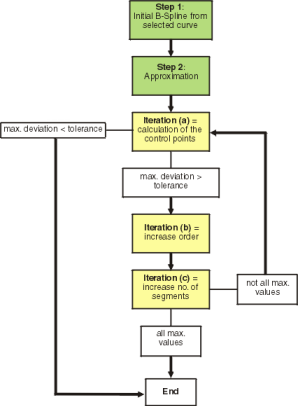About Approximation | ||
| ||
The approximation options are available in the Geometry area of the curve and surface creation command panels.
The
Approximation panel appears at the bottom of the
work area
when executing a surface creation command. Use
![]() and
and
![]() to
expand and collapse the panel.
to
expand and collapse the panel.
The approximation is computed in two steps:
-
Creation of an initial B-Spline
With the first step, for each selected curve is created an initial B-Spline, defining the parametrization and the number of control points, but not their values. The B-Spline results from the B-Spline of the curve to be approximated as well as from the minimum and maximum values of the order and the number of segments specified by the user:
Order and number of segments of the B-Spline are taken from the curve to be approximated, if they are within the specified minimum and maximum ranges. Otherwise, they are increased or reduced to the corresponding minimum or maximum value.
Note: If in the selected geometry G2 discontinuities are found, they are transferred as sharp bends to the initial B-Spline. In this case, the initial B-Spline may contain more segments than the maximum value specified for the segmentation. -
Iterations
After the creation of the initial B-Spline, the actual approximation is computed in the second step. This is realized by a three-step iteration:
-
Iteration (a)
In the first iteration, the (optimal) values of the control points of the B-Spline are computed using a Newton method. The control points allow the computation of the maximum deviation between the computed approximation curve and the original curve. If this value is smaller than the tolerance value specified by the user, the iteration is terminated successfully.
-
Iteration (b) + (c)
If the computed deviation is larger than the tolerance specified, the B-Spline will be modified by increasing order and number of segments, and the iteration (a) is restarted.
Independent from the approximation type set, first the order and then the number of segments is increased. This way, the number of segments of the created curves can be minimized.
-
Approximation Options
- Automatic
- Provides a better control of the order and segmentation based on the settings.
- Tolerance
- Controls the influence of the G0 tolerance. Provided that for Order and Segmentation the maximum values specified allow increasing the order, these values are increased iteratively until the deviation between the input geometry (or the theoretical results) and the approximation result keeps the G0 tolerance.
- Order
- Defines the order in u and v direction.
- Max: The maximum order is driven by the continuity conditions and is at least the maximum order of all input curves.
The initial order and segmentation for the surface calculation uses a linear single segment with order 2.
- INP: The order is taken from the maximum order of all input curves.
The initial segmentation for the surface calculation is taken from the first selected input curve.
- Max: The maximum order is driven by the continuity conditions and is at least the maximum order of all input curves.
- Max. Segments
- Increases or reduces the number of segments until it reaches the specified value.
